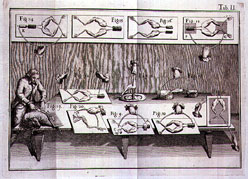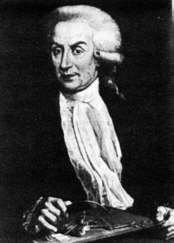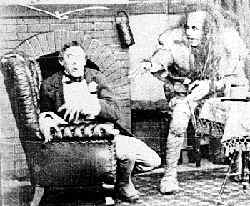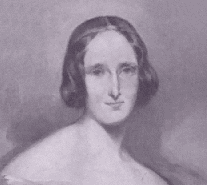PREVIEW
Forerunners of Mary Shelley: the Gothic Sensibility
Ann Radcliffe - The Gothic Romance
Mary and Mary: Mother and Daughter
Science in 1800
The Real Life of Mary Shelley
A Smooth Path?

Science in 1800

Life:
Blundell's Gravitator
Pennsylvania State University Libraries

James Blundell, a London physician troubled by the many women who died after childbirth from massive bleeding, introduced blood
transfusion between humans, using the simple apparatus shown here. Reproduction of an illustration from The Lancet, 1828-1829.
Galvanism:
During the 1790s, Italian physician Luigi Galvani demonstrated what we now understand to be the electrical basis of nerve
impulses when he made frog muscles twitch by jolting them with a spark from an electrostatic machine. When Frankenstein was
published, therefore, the word galvanism implied the release, through electricity, of mysterious life forces. "Perhaps," Mary Shelley
recalled of her talks with Lord Byron and Percy Shelley, "a corpse would be reanimated; galvanism had given token of such
things."

Illustration of Italian physician Luigi Galvani's experiments, in which he applied electricity to frogs legs; from his book
De Viribus Electricitatis in Motu Musculari (1792).
Luigi Galvani, 1737-1798, Italian physician and physicist.

Galvani's great interest was "animal electricity," which he studied in his post as a teacher of medicine
in Bologna. In 1780, he constructed a crude electric cell with two different metals and the natural
fluids from a dissected frog. In another experiment he applied current to the nerves of a frog and
observed the contractions of the muscles in their legs. This led to widespread speculation on the
relationship of biology, chemistry, and electricity, and perhaps encouraged speculation on medical
electricity, such as George Adams and Benjamin Franklin were exploring. His theoretical foundation
was later corrected by Alessandro Volta. For a contemporary account, consult William Nicholson's
entry in The British Encyclopedia (1809).
Childbirth:
Another Unknown Woman!!
Trotula of Salerno (??-1097)
Midwife, teacher, and author, Trotula's treatise on gynecology,
Passionibus Mulierum Curandorum (The Diseases of
Women), in which she identified herself as a woman, was used in medical schools until the sixteenth century. Long regarded as one of the preeminent medieval scientists, Trotula lost her place in the history of medicine only in the beginning of the 20th century when historians became unable to accept that such a woman could exist in eleventh-century Italy. Writing with disarming frankness, Trotula dealt with gynecology, obstetrics, cosmetics, and skin disease in a sensible and humane manner. Generally up-to-date for its time, Passionibus Mulierum was far ahead of the current practices when discussing surgery, analgesics, and the care of the mother and child during the post-partum period. Her topics included the need for cleanliness, a balanced diet, and regular exercise, warned of the effects of emotional stress, and discussed birth control, problems of infertility, male infertility, sewing (and avoiding) tears suffered in childbirth, repositioning a baby during a breech birth, and the problems of sex and celibacy. She even told how a woman might pretend to be a virgin. Unlike many other works of the period, her cures rarely include prayers, incantations, astrology, or other forms of blatant superstition.
Margaret Alic, Hypatia's Heritage, A History of Women in Science from Antiquity through the Nineteenth
Century,
Beacon Books, 1986, pp. 50-56
Pregnancy and childbirth, as well as death, were an integral part of Mary Shelley's young adult life. She had four children and a miscarriage that almost killed her. This was all before the age of twenty-five. Only one of her children, Percy Florence, survived to adulthood and outlived her. In June of 1816, when she had the waking nightmare which became the catalyst of the tale, she was only nineteen and had already had her first two children. Her first child, Clara, was born prematurely February 22, 1815 and died March 6. Mary, as any woman would be, was devastated by this and took a long time to recover.
Women and Childbirth
Two great curses haunted natural childbirth from ancient times, the shrunken pelvis and obstructed labour.
With urbanization and hospitalization, puerperal fever became common. Because so often mothers died in childbirth and children in infancy, attitudes towards birth and babies were different from ours. Parents expected that children would die in infancy, and death in childbirth was an expected tragedy.
In developed countries, child mortality is now low, and maternal mortality a rare catastrophe; the natural phenomena of birth up till this century can be best understood by a quotation from an XVIIIth century Scottish obstetrician, William Smellie:
Case 454 Natural delivery; death from cold afterwards. In the beginning of my practice I was sent for in a cold frosty night to a poor woman in the country, who had been safely delivered. As she was excessively cold all the time of labour from the badness of the house, the want of clothes and the necessities of life, I gave her husband some money to go to an alehouse at a mile distance and bring from thence something comfortable. I left directions with the midwife to get her warm as soon as possible. The fellow got drunk and did not return for several hours. I was told afterwards that the cold and shivering continued, and the poor creature died the next morning. Indeed as there was little or no fuel for fire, both the midwife and I caught severe colds; for it was a lone house and at a distance from any inhabited neighbourhood.
The classical Romans had considerable obstetric skill. Soranus (A.D. 98-138), wrote a textbook of obstetrics which was used until the sixteenth century. Soranus described podalic version, and the use of the obstetric chair, and gave detailed instructions on the care of the new- born-- boiled water and honey for the child for the first two days, then on to the mother's breast.
These skills largely disappeared during the Dark Ages; there is little record of obstetric practice after this until early modern times. Presumably obstetrics during the Dark Ages was a matter for the mid-wife, and no doubt, free of the possibilities of infection found in a large hospital, she did a good job. We know some of the superstitions: women were whipped to induce
labour. There is a tale of a mediaeval German Empress in whose labour room 20 men were whipped, two to death. She went into successful
labour. We know of Dr Wertt of Hamburg in 1522, who had the effrontery to dress up in woman's clothes to gain entry to a labour room; and who was thereafter burned at the stake. The new medical knowledge of the Renaissance was spread by the printing press. The first book on obstetrics in English --The Birth of Mankynde was produced in 1544 by Thomas
Raynalde. In it he considers such problems as caesarean section. The whole process of pregnancy was considered by Jacob Rueff (1500-1558) in his De conceptu generationis hominis, published in 1554. There followed a spate of publications applying the new techniques of anatomy and anatomical illustration to obstetrics.
Ambrose Pare (1509-1589) apprenticed in a small rural town, and then further trained in the famous Paris Hotel Dieu in the midst of a busy surgical life, had like most surgeons of his time obstetric skills. Of podalic version he wrote
...he must lift him (the baby) up gently, and so turn him that his feet come first--then little by little turn the whole body
from the womb. Pare induced labour by dilating the cervix, and first used nipple shields, made of lead, to protect cracked nipples. William Harvey who discovered the circulation of the blood practised obstetrics, and wrote a major text on Reproduction, giving for instance the first description of involution of the uterus, post partum.
Obstructed labour terrified women --William Smellie wrote:
Case 386. A neglected transverse lie. The arm had been pulled down by the midwife till the shoulder was at the vulva.
Twenty four hours later Smellie was sent for, cut off the swollen arm, performed internal version and brought down one
leg. This came off on pulling, so the other leg was brought down and the same thing happened again. Ultimately delivery
was accomplished with the crotchet. The woman behaved with great courage............
A History of Childbirth in the
United States
Until the late 1930s, childbirth was the domain of women. Pregnant women gave birth at home, generally with other women attending the birth. Anesthesia and pain medications were not standard practices. Then, a curious transformation occurred. Hospital births became the norm. In the 1940s and 1950s women flocked to the hospital to give birth. Male physicians attended the births. It became common practice to anesthetize women during labor to eliminate any pain during childbirth. The expectant father was relegated to the waiting room to protect him from the "gruesome reality" of childbirth.
Europeans experienced a similar change in birthing practices. However, by the late 1940s, several European men began questioning the use of general anesthesia during labor and birth. In France, Dr. Ferdinand Lamaze developed "childbirth without pain", the Lamaze method. Dr. Lamaze observed women in the Soviet Union give birth
without anesthesia. The women had been trained to use specific breathing patterns and relaxation techniques with the assistance of a trained woman, called a "monitrice." The Russian childbirth system was based on Pavlovian conditioning. Dr. Lamaze borrowed from this technique. In addition, he developed a series of breathing patterns to
use during labor. He also implemented the use of intense concentration by teaching women to stare at a focal point (this technique appears in many hospital-based education classes). The Lamaze method gained popularity in the United States after Marjorie Karmel wrote of her childbirth experience using Lamaze in the 1957 book, Thank You, Dr.
Lamaze.
At about the same time in England, Dr. Grantly Dick-Read began to advocate natural childbirth. Dick-Read had started as a
physician who supported the use of anesthesia during childbirth. After assisting at a natural childbirth, he became a supporter of drug-free delivery. Coining the term "childbirth without fear," Dick-Read emphasized relaxation
techniques and prenatal education. For a long time, Dick-Read gained some attention in England, but no following within the United States.
In the early 1950s, Dr. Bradley, an American obstetrician, became familiar with the work of Dick-Read. He believed that women should be awake during childbirth. Bradley became an advocate of natural childbirth. While most practitioners left men in the waiting room, Bradley felt that husbands should in the birth experience. He focused
on educating the pregnant couple so that the husband could serve as a "coach" during labor. The Bradley Method®, also known as Husband-Coached Childbirth, emphasized education, controlled breathing and relaxation, breastfeeding, and maternal nutrition and exercise..
In the 1970s, Natural Childbirth was the vogue. Although most women continued to deliver in hospital settings, couples flocked to Lamaze and Bradley Method classes. Medication-free childbirth became a female initiation rite. Women who failed to manage a natural childbirth (either because they were unable to tolerate the pain or because they required
a cesarean) felt like failures. As women became more educated about childbirth, they began to question the medical status quo. Women began to demand alternatives to the sterile hospital environment, the hard delivery tables and stirrups, and the "disease" approach to childbirth. As proponents of early
breastfeeding, they questioned the
practice of whisking the baby off to the nursery. Natural childbirth advocates regarded birth as a normal process which should occur in a warm setting with family present. Despite a lot of divisiveness, consumer demand for changes began to result in changes in hospital practices.
While natural childbirth was gaining praise, physicians were making advances in pain control during labor. The development of the epidural altered the birth experience for mothers who used medications. Suddenly, a woman could obtain pain control with drugs without losing alertness or awareness of the birth and without delivering a sluggish,
"drugged" baby. Even more amazingly, women who required cesarean sections no longer had to have general anesthesia and miss the arrival of the baby. Other intravenous pain medications also allowed for pain
control without significant depression of the central nervous system.
As the 1970s faded, attitudes toward childbirth became more muted. The natural childbirth movement remained vibrant, but many women opted for pain medications during labor. A small percentage of women
were delivering in birthing centers or at home, but more than 90% of women in the United States continued to have babies in the hospital setting. However, the hospital setting was dynamically altered. In response to consumer demand, hospitals routinely invited men into the delivery rooms (and even into surgery for cesareans). Birthing rooms
were enlarged to accommodate family members. Curtains were hung and rocking chairs became popular. Women were allowed to remain in one room throughout their stay, and "rooming in" with baby became quite popular.
While decors have changed over the years, "family-centered maternity care" and "prepared childbirth" have become the norms. Prepared childbirth stresses the importance of educating a couple to enable them to make informed, personal decisions about their labor and delivery experience. Within the framework of prepared childbirth, couples are
taught about all the possible eventualities of labor, including natural or medicated labors, cesareans, and episiotomies. "Family-centered maternity care" is currently the popular hospital marketing strategy. Ideally, family-centered care recognizes that the birth of a child represents the birth of a new family, a significant life event. Thus, the
care approach should honor the sanctity of the family by accommodating the birth wishes of a couple. Family centered care respects the autonomy of the family members and approaches childbirth decisions in a
non-judgmental fashion.
The childbirth experience has changed dramatically over the years. Since the 1950s, women have had the opportunity to move from passive victims to active participants in the birth experience. Natural childbirth is still regarded as the ideal, and there are several effective educational training programs for women striving for this birth choice.
Currently, more than 90% of women deliver in hospital settings and most women use obstetricians. A small number of women use midwives and deliver in birthing centers or at home. Most men remain at their partners side during delivery. Couples have a key role in planning and achieving the birth experience they desire.
Body Parts
To make his creature, Victor Frankenstein "dabbled among the unhallowed damps of the grave" and frequented dissecting rooms
and slaughterhouses. In Mary Shelley's day, as in our own, the healthy human form delighted and intrigued artists, physicians, and
anatomists. But corpses, decaying tissue, and body parts stirred almost universal disgust.
Alive or dead, whole or in pieces, human
bodies arouse strong emotion - and account for part of Frankenstein's enduring hold on us.
a youtube clip of the early Frankenstein





The Real Life of Mary Shelley

Mary Shelley, born August 30, 1797, was a prominent, though often overlooked, literary figure
during the Romantic Era of English Literature. She was the only child of Mary
Wollstonecraft, the
famous feminist, and William Godwin, a philosopher and novelist. She was also the wife of the poet
Percy Bysshe Shelley. Mary's parents were shapers of the Romantic sensibility and the revolutionary
ideas of the left wing. Mary, Shelley, Byron, and Keats were principle figures in Romanticism's
second generation. Whereas the poets died young in the 1820's, Mary lived through the Romantic era
into the Victorian.
Mary was born during the eighth year of the French Revolution. "She entered the world like the heroine
of a Gothic tale: conceived in a secret amour, her birth heralded by storms and portents, attended by
tragic drama, and known to thousands through Godwin's memoirs. Percy Shelley would elevate the
event to mythic status in his Dedication to The Revolt of Islam".( from pg. 21 of Romance and
Reality by Emily Sunstein.) From infancy, Mary was treated as a unique individual with remarkable
parents. High expectations were placed on her potential and she was treated as if she were born
beneath a lucky star. Godwin was convinced that babies are born with a potential waiting to be
developed. From an early age she was surrounded by famous philosophers, writers, and poets:
Coleridge made his first visit when Mary was two years old. Charles Lamb was also a frequent visitor.
A peculiar sort of Gothicism was part of Mary's earliest existence. Most every day she would go for
a walk with her father to the St. Pancras churchyard where her mother was buried. Godwin taught Mary
to read and spell her name by having her trace her mother's inscription on the stone.
At the age of sixteen Mary ran away to live with the twenty-one year old Percy Shelley, the unhappily
married radical heir to a wealthy baronetcy. To Mary, Shelley personified the genius and
dedication to human betterment that she had admired her entire life. Although she was cast out
of society, even by her father, this inspirational liaison produced her masterpiece, Frankenstein.
She conceived of Frankenstein during one of the most famous house parties in literary history when
staying at Lake Geneva in Switzerland with Byron and Shelley. Interestingly enough, she was only
nineteen at the time. She wrote the novel while being overwhelmed by a series of calamities in her
life. The worst of these were the suicides of her half-sister, Fanny Imlay, and Shelly's wife, Harriet.
After the suicides, Mary and Shelley, reluctantly married. Fierce public hostility toward the couple
drove them to Italy. Initially, they were happy in Italy, but their two young children died there. Mary
never fully recovered from this trauma. (Their first child had died shortly after birth early in their
relationship.) Nevertheless, Shelley empowered Mary to live as she most desired: to enjoy
intellectual and artistic growth, love, and freedom.
When Mary was only twenty-four Percy drowned, leaving her penniless with a two year old son.
For her remaining twenty-nine years she engaged in a struggle with the societal disapproval of her
relationship with Shelley. Poverty forced her to live in England which she despised because of the
morality and social system. She was shunned by conventional circles and worked as a professional
writer to support her father and her son. Her circle, however, included literary and theatrical figures,
artists, and politicians.
She eventually came to more traditional views of women's dependence and differences, like her
mother before her. This not a reflection of her courage and integrity but derived from socialization
and the conventions placed on her by society.
Mary became an invalid at the age of forty-eight. She died in 1851 of a brain tumor with poetic timing.
The Great Exhibition, which was a showcase of technological progress, was opened. This was the
same scientific technology that she had warned against in her most famous book, Frankenstein.
other interesting pieces on the biographical and critical details
surrounding the life of Mary
Shelley.
A Smooth Path?
The actual life of Mary Shelley was tragic in many
ways. Despite the fact that she had written a novel that would
inspire imitation for over two hundred years, she suffered through the
loss of children, grinding poverty, and general neglect. She also
fits into many of the stereotypes and patterns we have been looking at in
our survey.










